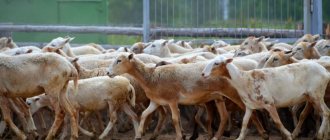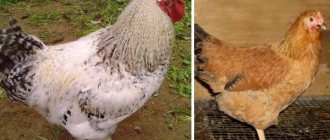Keeping chickens in a greenhouse in winter
The idea of equipping a greenhouse for a chicken coop in winter was quickly picked up and spread everywhere. And the availability of frost-resistant, durable, transparent to light and good-looking polycarbonate has become a good help in arranging such a room for birds.
Did you know? A day-old chick, with its existing reflexes and level of development, demonstrates abilities that a child achieves only at the age of three.
Advantages
- Advantages of using a greenhouse in the form of a winter chicken coop:
- it becomes possible to significantly save money and space on the site required for the construction of a separate poultry house;
- reliable protection of the bird from bad weather, frost and predators is created;
- chicken stock is preserved during the cold season;
- chicken droppings accumulate, which are collected in replaceable bedding, which is then well suited for making compost, and also serves as an excellent fertilizer for plants in the summer.
Flaws
- To equip a greenhouse for a winter chicken coop, you cannot do without some hassle:
- a polycarbonate greenhouse must be insulated, which entails certain costs;
- inside you will have to build perches, nests, feeders and drinking bowls;
- In the spring, all this needs to be dismantled and a place to store it must be found.
Tricks and subtleties of content
Chickens in a greenhouse have enough space, but require care and compliance with sanitary standards. The dishes should be collapsible so that they can be easily washed. A balanced diet, a comfortable microclimate and properly selected equipment will help you obtain products consistently.
How to assemble a feeder
The powerful legs of chickens allow them to row everything they encounter on their way. Because of this, feeders are chosen as closed as possible and installed above the floor. Its perimeter should be calculated taking into account the number of chickens. And to ensure the timely supply of feed, bunker-type feeders are fixed, which can be easily made from available material (for example, a plastic bottle).
How to make a drinking bowl
As for drinking bowls, the main requirement remains the same: to protect the water from dirty paws. You can use open options, for example, from pipes for sewerage, which are plugged on both sides, and holes are made on top so that you can drink through them. Automatic drinking bowls are installed - capacious containers, inverted onto a basin or plate, into which water flows as it is used. The feeder is installed away from the drinking bowls so that the food does not become sour from the water that gets into it.
Food in winter
A balanced diet will help you survive the winter without illness. Chickens should be fed grain (50 g), potatoes boiled and mashed with flour (100 g), mash with mineral elements (30 g), vitamin supplement with bran (30 g), hay flour (10 g). In addition to the above, the diet should include crushed fish, meat, cottage cheese, bone meal, eggshells, and fresh herbs obtained from sprouted grains.
Sand is poured into one of the feeders, which is needed for normal digestion. Laying hens should be given feed in doses, otherwise they will become fat and will not lay eggs. To avoid aspergillosis, remember the peculiarities of storing grains - only in a dry, well-ventilated room. Compliance with all maintenance standards will keep your livestock healthy and productive in the winter.
Setting up a greenhouse for a chicken coop for the winter
If there is a greenhouse on the site, arranging it for a chicken coop is not so difficult. Basically, it needs to be insulated and equipped inside with feeders, drinkers, perches, nests and, if necessary, forced ventilation and heating.
Did you know? The notorious “chicken brains,” however, allow the laying hen to remember over a hundred human faces and from 10 meters accurately recognize the owner among other people.
Materials and tools for work
To use a polycarbonate greenhouse as a chicken coop, you will need the following tools and materials:
- wood saw;
- hacksaw for plastic;
- screwdriver;
- hammer;
- gun for using sealant;
- nails;
- rubberized gaskets;
- thiokol or polysulfide mastic;
- polycarbonate sheets up to 4 mm thick;
- round wooden beams or poles;
- polystyrene foam 5 cm thick;
- lutrasil;
- boards for constructing chicken nests and a ladder leading to the perches;
- electric wires;
- electric lamps;
- electrical outlets.
DIY winter chicken coop from a greenhouse: video
Step-by-step instruction
To equip a greenhouse for a winter chicken coop, you must:
- To prevent drafts, use rubberized gaskets to seal all cracks at the joints of the structure.
- Eliminate gaps between polycarbonate sheets using a sealant in the form of thiokol or polysufide mastic.
- In areas with a cold climate, insulate the room from the inside with a second layer of polycarbonate up to 4 mm thick or bubble wrap.
- Dig out the foundation and cover it with foam plastic slabs 5 cm thick.
- Tighten polycarbonate walls from the inside with lutrasil to prevent condensation and for additional insulation.
- Install electrical wiring into the greenhouse for lighting, heating and forced ventilation.
- Place perches made of round timber or poles inside at a rate of 25 cm for each bird. Perches are placed higher because warm air rises. A ladder or wooden ladder should lead to them.
- For laying hens, make nests in the form of boxes measuring 30x40x30 cm with a mesh bottom covered with sawdust or hay. The nests are located in the least lit part of the room.
- Install feeders for dry and wet food raised above the floor surface.
- Install an automatic nipple or vacuum drinker.
Important! On the outside, if the greenhouse frame is sufficiently strong, snow serves as a good insulator.
How to raise chickens in a greenhouse in winter
To ensure that chickens wintering in a greenhouse feel comfortable in it, simple rules should be followed.
Basic wintering rules
They are as follows:
- The temperature in the poultry house should not fall below +10 °C, and for laying hens the minimum temperature is +15 °C. On frosty days it can be maintained using infrared lamps. Moreover, for every 10 sq. m of greenhouse area, one lamp with a power of 500 W is enough.
- Daylight should be artificially maintained for at least half a day to ensure high egg production of chickens at the rate of 1 lamp per 20 W for every 10 square meters. m.
- The floor should not be cold, for which it is covered with an insulating bedding made of hay, straw or peat with a height of at least 10 cm.
- Usually in such greenhouses for every 10 sq. m have two vents for ventilation. But in winter, in windy and frosty weather, they cannot be used, and therefore in the greenhouse used as a poultry house, forced ventilation is installed, creating air movement not exceeding 2 m/sec.
It will be useful for you to learn how to make a mini-chicken coop and a winter chicken coop with your own hands, and also learn how to build a small chicken coop for 5 chickens and a large one for 50.
Feeding chickens
In winter, chickens are deprived of green mass, seeds of various plants and insects, to which they had access while walking in the warm season.
All this has to be compensated by balancing the feed, which is given to the chickens four times a day in winter and consists of:
- cereals, represented by oats, wheat, rye, crushed corn and barley;
- mixtures of boiled and mashed potatoes with flour;
- mash of crushed grains, steamed vegetables and mineral additives such as crushed shells, dried egg shells and chalk chips;
- bran with fortified supplement;
- hay flour;
- protein supplements consisting of fish and meat waste, cottage cheese, steamed peas and beans.
Important! Laying hens should not be given a lot of feed to avoid obesity, leading to a drop in egg production.
As in the summer, in winter the following should not be given to chickens as food:
- baked goods that swell in the stomach and disrupt the functioning of the digestive tract;
- sausages containing substances harmful to poultry;
- sweet foods that cause obesity;
- raw potatoes containing poisonous solanine;
- stale products that can lead to poisoning.
Since in the greenhouse where chickens live in winter, the temperature cannot be lower than +10 ° C, then the water should not be colder than this temperature.
How to keep your chicken coop clean in winter
The main concern in sanitary terms is to prevent litter from getting into the feed and water in feeders and drinkers and timely treatment of the bedding on the floor. For this purpose, automatic drinkers of nipple and vacuum types are installed, which protect drinking water from contact with down, feathers and bird droppings.
The arrangement of feeders raised above the floor and designed in such a way that birds can stick only their heads into them also contributes to the observance of hygienic rules for feeding chickens.
Learn how to properly disinfect a chicken coop.
Bedding material is usually made from:
- straw:
- hay;
- sawdust;
- peat;
- wood shavings;
- chaff.
The most practical bedding material is peat, which can absorb liquid waste 20 times its own weight. As for replacing litter, poultry farmers practice two approaches. Some change the litter either completely or its upper part twice a month.
Others leave the old litter in place, supplementing it with a fresh layer poured on top of the old one. The meaning of this is that the lower layers of litter, soaked in droppings, begin to rot, releasing heat (up to +40 ° C): this is a big plus for a winter poultry house.
Recently, “Net-plast” enzymes, mixed with permanent bedding, have been increasingly used. As a result of fermentation, bacteria not only accelerate the processes of decomposition in the litter and the release of heat, but also significantly dampen the unpleasant odor in the greenhouse.
Organization of walking
In winter, bird walks in the fresh air are mandatory. It is best to do this in sunny weather and in the absence of frost.
Important! Temperatures below –10 °C are undesirable for chickens to walk, as they can lead to frostbite on their paws and colds.
Usually in winter, chickens walk outdoors for no longer than 2 hours. The walking area is lined with hay or used bedding from the poultry house.
What affects egg production in chickens in winter?
Typically, in winter, a decrease in egg production is affected by:
- natural biorhythms of birds;
- low temperature;
- decreasing daylight hours;
- decreased physical activity, causing obesity;
- vitamin deficiency.
However, all this, with the exception of natural biorhythms, is regulated by humans, as a result of which almost the entire winter period it is possible to obtain a full number of eggs from laying hens.
Pros of an ergonomic polycarbonate chicken coop
To summarize, let's talk about the advantages of keeping poultry in a unique polycarbonate house.
Comfort
First of all, the comfort of the birds is ensured. In a polycarbonate chicken coop they will always be light, cozy and warm. The large amount of space saved will also not go unnoticed by birds. According to the experience of many farmers, the more spacious the chicken coop, the more comfortable it is for laying hens, which means you get a lot more eggs.
Polycarbonate chicken coop is spacious and comfortable
To cope with the “greenhouse” heat in the chicken coop in the summer, prepare thick fabric canopies for the house. Such a device will protect the interior space from sunlight, and therefore reduce the level of heat.
Possible diseases and their treatment
In winter, chickens are susceptible to diseases that result from:
- colds;
- infections;
- injuries, poisoning;
- parasite activity.
Most often in winter, chickens suffer from:
- Laryngotracheitis , which is an infectious disease and manifests itself in inactivity, decreased egg production, hoarse breathing, and the formation of conjunctivitis. Infectious laryngotracheitis is treated with Tromexin, which is given at the very beginning of the disease in the amount of 2 g diluted in a liter of water, and then until the chicken’s final recovery, 1 g dissolved in a liter of water.
- Bronchopneumonia , which is bronchial inflammation and manifests itself in hoarse breathing, immobility, runny nose, and loss of appetite. For treatment, spraying of “Ashpiseptol” in the chicken coop is used, as well as doses of “Terramycin” or “Norfloxacin” determined by the veterinarian. Preventive measures include compliance with the recommended temperature regime and acceptable humidity level in the poultry house.
- Pullorosis , which is fowl typhus and affects the intestines of chickens. The disease manifests itself in a sharp decrease in appetite, increased temperature, and the appearance of diarrhea. Treatment consists of taking sulfa drugs for a week.
- Colibacillosis , which affects the entire chicken flock and primarily affects the lungs of the bird. The disease manifests itself in lethargy, increased temperature, a sharp deterioration in appetite, hoarse breathing, and severe thirst. Treatment consists of chickens taking Sarafloxalin, Enrofloxacin and Ampicillin, the dose of which is determined by a veterinarian in each specific case.
- Salmonellosis , which is a disease transmitted by the salmonella bacterium and affecting the internal organs of chicken. The disease manifests itself in the chicken's apathy, loss of appetite, difficulty breathing, and lameness. During the treatment of the disease, Sulfanilamide, Biomycin, Chloramphenicol, Tetracycline, Chlortetracycline are used.
The idea of using a greenhouse in the form of a poultry house that is idle during the cold season for the winter keeping of chickens is finding more and more supporters and followers. With a little additional equipment, a polycarbonate greenhouse becomes an excellent home for wintering laying hens.
Polycarbonate chicken coop: we build it from scratch with our own hands
In the harsh Russian winters, poultry farming is complicated by the need to build an ergonomic chicken coop, warm in winter and cool in summer. Sometimes frosts reach temperatures of –40°C and below, which leads to water freezing and the occurrence of colds in timber chicken coops. Many farmers cannot afford to install a permanent brick poultry house, however, a solution must be found, because serious cooling causes the inevitable death of their feathered charges. Don't worry - there is a way out! In this article we will tell you how to build a polycarbonate chicken coop for birds and equip it for comfortable living.
How to build a polycarbonate chicken coop yourself










